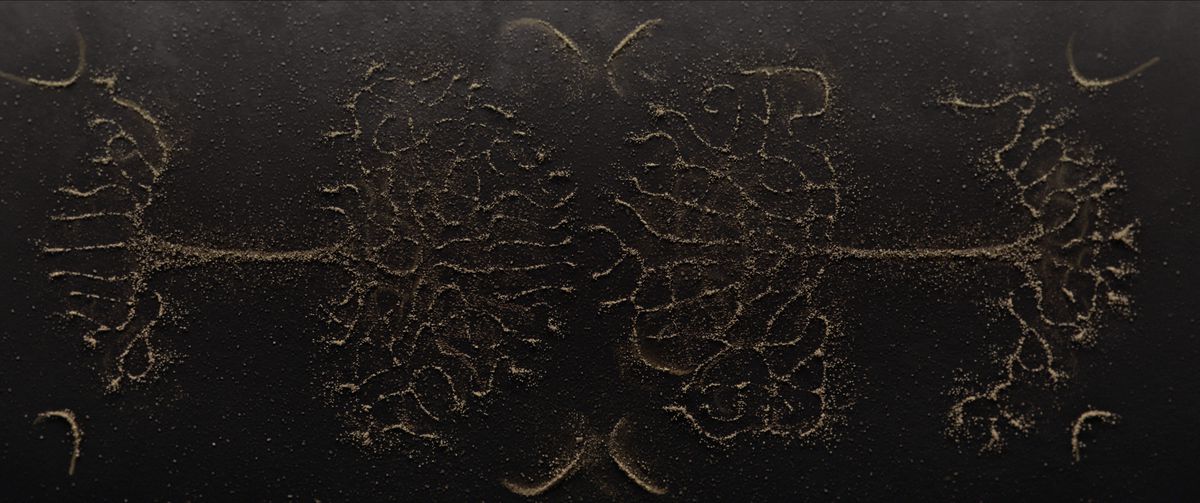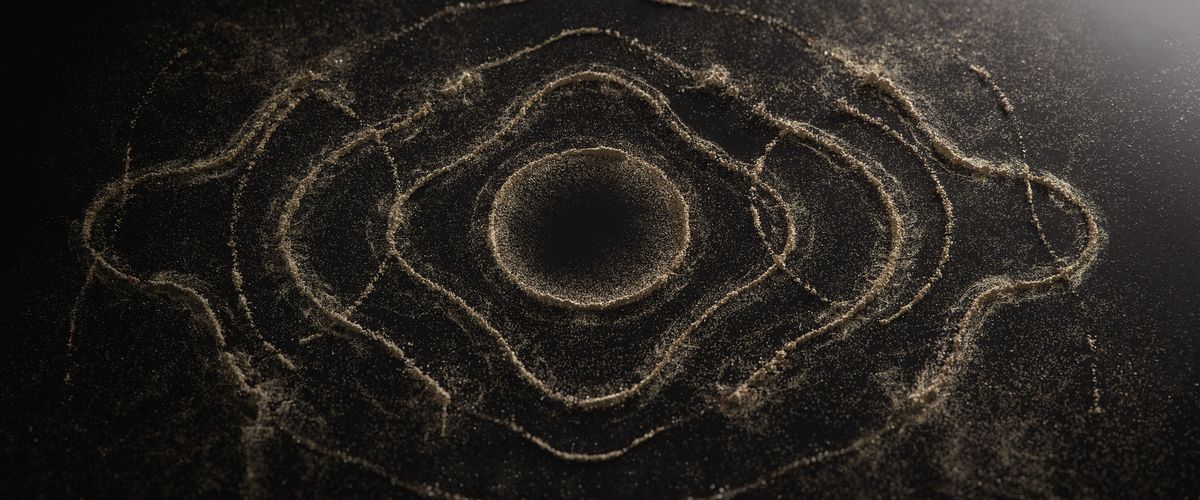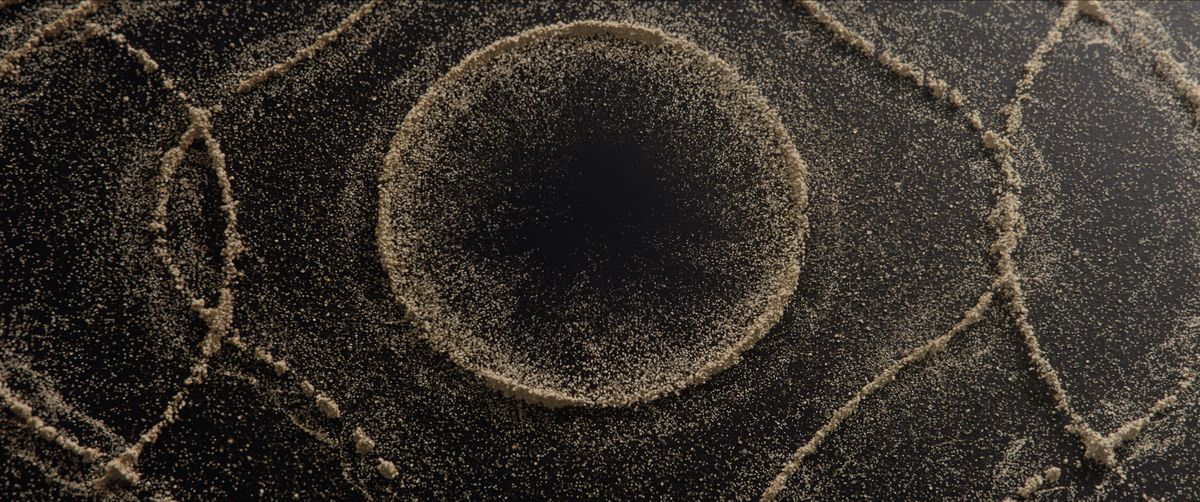The opening for The Lord of the Rings: The Rings of Power, the Prime Video original series, is one of the most visually striking title sequences to premiere on television this year. Over the course of 90 seconds, a series of wispy veins of granite, pebble, and ichor morph and flow across the screen into a latticework of intricate symbols inspired by J.R.R. Tolkien’s writing, coalescing into a sequence that feels at once both ancient and timeless in its execution.
The sequence, co-directed by Katrina Crawford and Mark Bashore of the Seattle-based film studio Plains of Yonder, was one of five ideas pitched by their team to the showrunners.
“It was glued directly to the Tolkien universe, with sound and music being fundamental to his world,” Bashore said in an interview with Polygon. “One of the first things we said when we showed the showrunners some images was, ‘What if we made a title sequence that was built from the world of sound?’”
To achieve this, Crawford, Bashore, and their team drew inspiration from the field of cymatics, the study of sound wave phenomena and their visual representation. Coined by 20th-century natural scientist Dr. Hans Jenny, the most common and best-known iteration of cymatics is the Chladni plate, a device invented by the 18th-century German physicist Ernst Chladni to visualize modes of vibration.
“The concept [of cymatics] was really well loved,” Bashore told Polygon. “But of course, we had multiple moments of panic early on while trying to figure out how do we make this. So we started at the kitchen table. Katrina set up this really basic science rig assembled from cheap parts and an iPhone, and we would put sand on this rig and play different tones through it. Gregorian chants, angel music, rock and roll — you name it. And the sand would shift and move according to the sound. When we looked at the footage, we knew we were onto something.”
The opening title sequence took a total of seven months to complete from first proposal to final edit. The result is a combination of live-action footage and CG animation with an emphasis on emulating the imperfection inherent to cymatics itself.
“Real cymatics is kind of frenetic, kind of buzzy, and almost feral-looking. And we [were] always compositing that back in over and over again,” Bashore told Polygon. “Even on the most CG-heavy shots, we were pushing to put more of that flawed, wild motion back in.”
Image: Plains of Yonder/Amazon Studios

Image: Plains of Yonder/Amazon Studios
Crawford cited a lyric from Leonard Cohen’s “Anthem” — “There is a crack, a crack in everything/That’s how the light gets in” — as another inspiration for the opening title sequence. “We love that quote, and it ties both right into what we wanted out of the sequence and to the creation myth of Middle-earth. It almost feels like a rephrasing of Tolkien. There’s this discord that’s incorporated into the music that exists alongside the harmony. That’s how you build things; there’s these different sides, and that duality is what brings beauty. We loved that.”
Of course, any title sequence worth remembering is inseparable from its musical score; that’s especially true for one designed to visualize sound itself. Unlike the series, whose score was composed by God of War composer Bear McCreary, the title theme of The Rings of Power was written by Howard Shore, known for his work on Peter Jackson’s The Lord of the Rings trilogy.
Aside from Shore’s score and the concept of cymatics, the visuals for The Rings of Power’s opening are steeped heavily in the lore of Tolkien’s universe, with Crawford directly citing the godlike Ainur as an influence that bridges the divide between the sequence’s real-life inspiration and the world of the series. “When you read the origin story, Tolkien very clearly writes out that you have Eru Ilúvatar, this godlike father who created the Ainur and is telling them to take their powers and put their own kind of personality and things into the universe. They’re building and harmonizing and weaving together the universe through song. So that sense of awe and wonder is very cool and that very much inspired us in trying to think about how we could represent that in the sequence.”

Image: Plains of Yonder/Amazon Studios

Image: Plains of Yonder/Amazon Studios
The concept of resonance happened to come up in the second episode of the show, when the dwarven princess Disa speaks about it to Elrond about the dwarven ability to conjure meaning from “songs” sung by the mountains of Khazad-dûm. These parallels, however uncanny, were not planned.
“That was just a happy coincidence; we saw nothing while making the sequence,” Crawford told Polygon. “We saw no scripts, nothing. We based all of our ideas primarily from Tolkien’s writing itself.”
Crawford sees parallels between the title sequence and the opening of episode 4, “The Great Wave,” where the Númenórean queen regent Míriel dreams of the destruction of her homeland. “That whole scene about transitions and impermanence ties right back into the theme of our sequence and the theme of Tolkien’s writing. We’re forming something, and then it’s immediately being crushed, and maybe something took eons to form, but there’s always a flex to the universe. Something may be ‘forever,’ but it’s not permanent.”
Anticipation for every aspect of the show, including the title sequence, reached a fever pitch in the days leading up to the premiere of The Rings of Power. So much so that a montage of the series’ characters, originating from an Entertainment Weekly cover story, was confused for the opening and went viral.
“Somebody sent that to us when it kind of caught fire and became this big humorous thing,” Bashore told Polygon. “And it is hilarious. The best one I saw was someone describing it as walking through downtown Portland at 11 p.m. If they ever make a Lord of the Rings comedy series, that would make an excellent main title.”
Ultimately, Crawford and Bashore are relieved and elated by the reception of the actual title opening. “We finished this thing quite a while ago, because it has to be translated into 60-something languages and so on,” Bashore told Polygon. “So it feels good to finally have it actually out there.”
Ultimately, what Crawford and Bashore are most proud of is having created an abstract and artful opening for such a high-profile television series, especially one with as rich and established history as The Lord of the Rings.
“We try to be very respectful of the fact that audiences can hit that ‘skip intro’ button. We want to respect that existing intelligence and knowledge when it comes to a show like this,” Crawford says. “There are people who come to this show with no knowledge of Tolkien, and there’s people who come to the show who are professors of Tolkien’s world. Do you feel a sense of epic timeliness when you watch the sequence? Are you ready when the show actually starts? If that works, then we did our job.”

